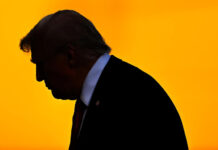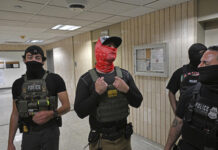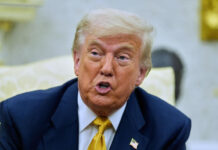NOVEMBER 18, 2022
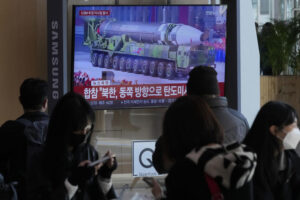
A TV screen shows a file image of North Korean missile in a military parade during a news program at the Seoul Railway Station in Seoul, South Korea, Friday, Nov. 18, 2022. South Korea says the missile North Korea launched Friday morning is likely an intercontinental ballistic missile. (AP Photo/Ahn Young-joon)
SEOUL, South Korea — North Korea fired an intercontinental ballistic missile that landed near Japanese waters Friday in its second major weapons test this month that showed a potential ability to launch nuclear strikes on all of the U.S. mainland.
The North’s ongoing torrid run of weapons tests aim to advance its nuclear arsenal and win greater concessions in eventual diplomacy and they come as China and Russia have opposed U.S. moves to toughen sanctions aimed at curbing North Korea’s nuclear program.
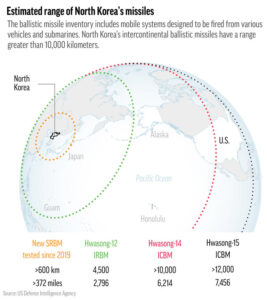
Map shows missile ranges of North Korea’s arsenal
The South’s Joint Chiefs of Staff said it detected the ICBM launch from North Korea’s capital region around 10:15 a.m. and the weapon flew toward the North’s eastern coast across the country. Japan said the ICBM appeared to have flown on a high trajectory and landed west of Hokkaido.

Japanese Defense Minister Yasukazu Hamada arrives at the prime minister’s office in Tokyo, Friday, Nov. 18, 2022. North Korea fired a suspected intercontinental ballistic missile that landed near Japanese territorial waters Friday, its neighbors said, the second such major weapons test this month that shows its determination to perfect weapons systems targeting the U.S. mainland. (Kyodo News via AP)
According to South Korean and Japanese estimates, the North Korean missile flew about 6,000-6,100 kilometers (3,600-3,790 miles) at a maximum altitude of 1,000 kilometers (620 miles).
Japanese Defense Minister Yasukazu Hamada told reporters the altitude suggests the missile was launched on a high angle. He said depending on the weight of a warhead to be placed on the missile, the weapon has a range exceeding 15,000 kilometers (9,320 miles), “in which case it could cover the entire mainland United States.”
Hamada called the launch “a reckless act that threatens Japan as well as the region and the international community.” He said Japan would continue to cooperate closely with the United States, South Korea and other countries to coordinate a joint response to North Korean provocations.
South Korea’s Joint Chiefs of Staff called the launch “a grave provocation and serious threat” to undermine international and regional peace and security. It said South Korea maintains readiness to make “an overwhelming response to any North Korean provocation” amid close coordination with the United States.
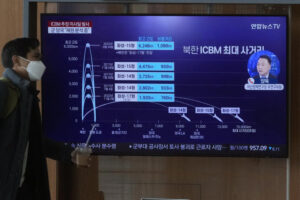
A TV screen shows a news program reporting on North Korea’s missile launch at the Seoul Railway Station in Seoul, South Korea, Friday, Nov. 18, 2022. North Korea fired a suspected long-range missile designed to strike the mainland U.S. on Friday, its neighbors said, a day after the North resumed its testing activities in an apparent protest over U.S. moves to solidify its alliances with South Korea and Japan. The sign reads “North Korea ICBM maximum range.” (AP Photo/Ahn Young-joon)
Japanese Prime Minister Fumio Kishida, in Bangkok to attend a regional summit, earlier told reporters the missile was believed to have landed at sea inside Japan’s exclusive economic zone west of Hokkaido, Japan’s main northern island.
North Korea also launched an ICBM on Nov. 3, but experts said that weapon failed to fly its intended flight and fell into the ocean after a stage separation. That test was believed to have involved a developmental ICBM called Hwasong-17. North Korea has two other types of ICBM — Hwasong-14 and Hwasong-15 — and their test-launches in 2017 proved they could potentially reach parts of the U.S. homeland.
The Hwasong-17 has a longer potential range than the others, and its huge size suggests it’s designed to carry multiple nuclear warheads to defeat missile defense systems. Some experts say the Nov. 3 test showed some technological progress in the development of the Hwasong-17, given that in its earlier test in March, the missile exploded soon after liftoff.
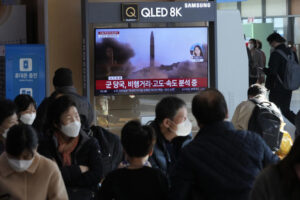
A TV screen shows a file image of North Korea’s missile launch during a news program at the Seoul Railway Station in Seoul, South Korea, Friday, Nov. 18, 2022. South Korea says the missile North Korea launched Friday morning is likely an intercontinental ballistic missile. (AP Photo/Ahn Young-joon)
South Korea’s presidential office said it convened an emergency security meeting to discuss the North Korean launch.
North Korea has performed many shorter-range missile tests and artillery displays this year but had halted weapons launches for about a week before it fired a short-range ballistic missile on Thursday.
Before Thursday’s launch, the North’s foreign minister, Choe Son Hui, threatened to launch “fiercer” military responses to the U.S. bolstering its security commitment to its allies South Korea and Japan.
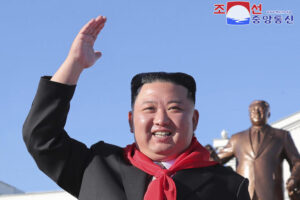
In this photo provided by the North Korean government, North Korean leader Kim Jong Un visits Mangyongdae Revolutionary School in Pyongyang, North Kora on Oct. 12, 2022. Independent journalists were not given access to cover the event depicted in this image distributed by the North Korean government. The content of this image is as provided and cannot be independently verified. Korean language watermark on image as provided by source reads: “KCNA” which is the abbreviation for Korean Central News Agency. (Korean Central News Agency/Korea News Service via AP)
Choe was referring to President Joe Biden’s recent trilateral summit with his South Korean and Japanese counterparts on the sidelines of a regional gathering in Cambodia. In their joint statement, the three leaders strongly condemned North Korea’s recent missile tests and agreed to work together to strengthen deterrence. Biden reaffirmed the U.S. commitment to defend South Korea and Japan with a full range of capabilities, including its nuclear arms.
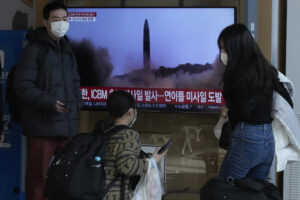
A TV screen shows a file image of North Korea’s missile launch during a news program at the Seoul Railway Station in Seoul, South Korea, Friday, Nov. 18, 2022. South Korea says the missile North Korea launched Friday morning is likely an intercontinental ballistic missile. (AP Photo/Ahn Young-joon)
Choe didn’t say what steps North Korea could take but said that “the U.S. will be well aware that it is gambling, for which it will certainly regret.”
Pyongyang sees the U.S. military presence in the region as proof of its hostility toward North Korea. It has said its recent series of weapons launches were its response to what it called provocative military drills between the United States and South Korea.
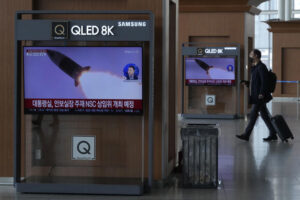
TV screens show a file image of North Korea’s missile launch during a news program at the Seoul Railway Station in Seoul, South Korea, Friday, Nov. 18, 2022. North Korea fired a suspected long-range missile designed to strike the mainland U.S. on Friday, its neighbors said, a day after the North resumed its testing activities in an apparent protest over U.S. moves to solidify its alliances with South Korea and Japan. (AP Photo/Ahn Young-joon)
There have been concerns that North Korea might conduct its first nuclear test in five years as its next major step toward bolstering its military capability against the United States and its allies.
North Korea has been under multiple rounds of U.N. sanctions over its previous nuclear and missile tests. But no fresh sanctions have been applied this year though it has conducted dozens of ballistic missile launches, which are banned by U.N. Security Council resolutions.
That’s possible because China and Russia, two of the U.N. council’s veto-wielding members, oppose new U.N. sanctions. Washington is locked in a strategic competition with Beijing and in a confrontation with Moscow over its invasion of Ukraine.
Courtesy/Source: AP


